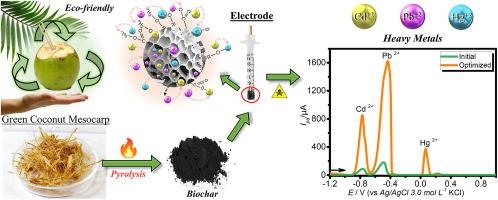Sustainable sensor from coconut waste for sensitive and simultaneous detection of heavy metals
IF 8.1
2区 环境科学与生态学
Q1 ENVIRONMENTAL SCIENCES
引用次数: 0
Abstract
Heavy metal detection is essential for both environmental monitoring and public health protection. Electrochemical sensors are a cost-effective and overly sensitive alternative to conventional analytical techniques, particularly when applied to complex matrices. In this study, biochars derived from green coconut mesocarp were synthesized via phosphoric acid activation followed by pyrolysis at four different temperatures. These materials were structurally and morphologically characterized and after used to fabricate chemically modified electrodes. Among the prepared materials, the electrode based on CMA300 exhibited the most favorable performance and was applied to the simultaneous detection of Cd2+, Pb2+, and Hg2+ using differential pulse voltammetry. Electrochemical studies revealed competitive adsorption phenomena, with Pb2+ showing prolonged retention on the electrode surface, for up to 1080 min, writing down favorable kinetic interactions. The CMA300 sensor demonstrated high sensitivities for Cd2+ (42.75 μA L μmol−1), Pb2+ (38.96 μA L μmol−1), and Hg2+ (8.07 μA L μmol−1), along with low detection limits, particularly for Cd2+ (LOD = 0.0014 μM), surpassing the performance of several reported sensors. Its low cost and straightforward preparation further underscore its potential for sustainable applications. Validation in six real samples, including sewage, cosmetic products, and tap water, yielded recovery rates between 89 % and 106 %, confirming the sensor's accuracy and selectivity in interference-rich matrices. Beyond its analytical merits, this work introduces a sustainable sensing platform derived from agro-industrial waste and offers new mechanistic insights into metal–electrode interactions through kinetic evaluation and surface adsorption analysis.

可持续传感器从椰子废料敏感和同时检测重金属。
重金属检测对环境监测和公众健康保护都至关重要。电化学传感器是传统分析技术的一种成本效益高且过于敏感的替代方法,特别是在应用于复杂矩阵时。本研究以绿椰子中果皮为原料,经磷酸活化后,在4种不同温度下热解制备了生物炭。这些材料在结构和形态上进行了表征,然后用于制造化学修饰电极。在制备的材料中,CMA300电极表现出最好的性能,并应用于差分脉冲伏安法同时检测Cd2+、Pb2+和Hg2+。电化学研究揭示了竞争性吸附现象,Pb2+在电极表面的滞留时间长达1080分钟,记录了有利的动力学相互作用。CMA300传感器对Cd2+ (42.75 μA L μmol-1)、Pb2+ (38.96 μA L μmol-1)和Hg2+ (8.07 μA L μmol-1)具有较高的灵敏度,对Cd2+ (LOD = 0.0014 μM)的检出限较低,优于已有的几种传感器。它的低成本和简单的制备进一步强调了其可持续应用的潜力。在包括污水、化妆品和自来水在内的六个实际样品中进行验证,回收率在89%到106%之间,证实了传感器在富含干扰的基质中的准确性和选择性。除了分析优点之外,本研究还介绍了一种源自农业工业废物的可持续传感平台,并通过动力学评估和表面吸附分析为金属-电极相互作用提供了新的机制见解。
本文章由计算机程序翻译,如有差异,请以英文原文为准。
求助全文
约1分钟内获得全文
求助全文
来源期刊

Chemosphere
环境科学-环境科学
CiteScore
15.80
自引率
8.00%
发文量
4975
审稿时长
3.4 months
期刊介绍:
Chemosphere, being an international multidisciplinary journal, is dedicated to publishing original communications and review articles on chemicals in the environment. The scope covers a wide range of topics, including the identification, quantification, behavior, fate, toxicology, treatment, and remediation of chemicals in the bio-, hydro-, litho-, and atmosphere, ensuring the broad dissemination of research in this field.
 求助内容:
求助内容: 应助结果提醒方式:
应助结果提醒方式:


